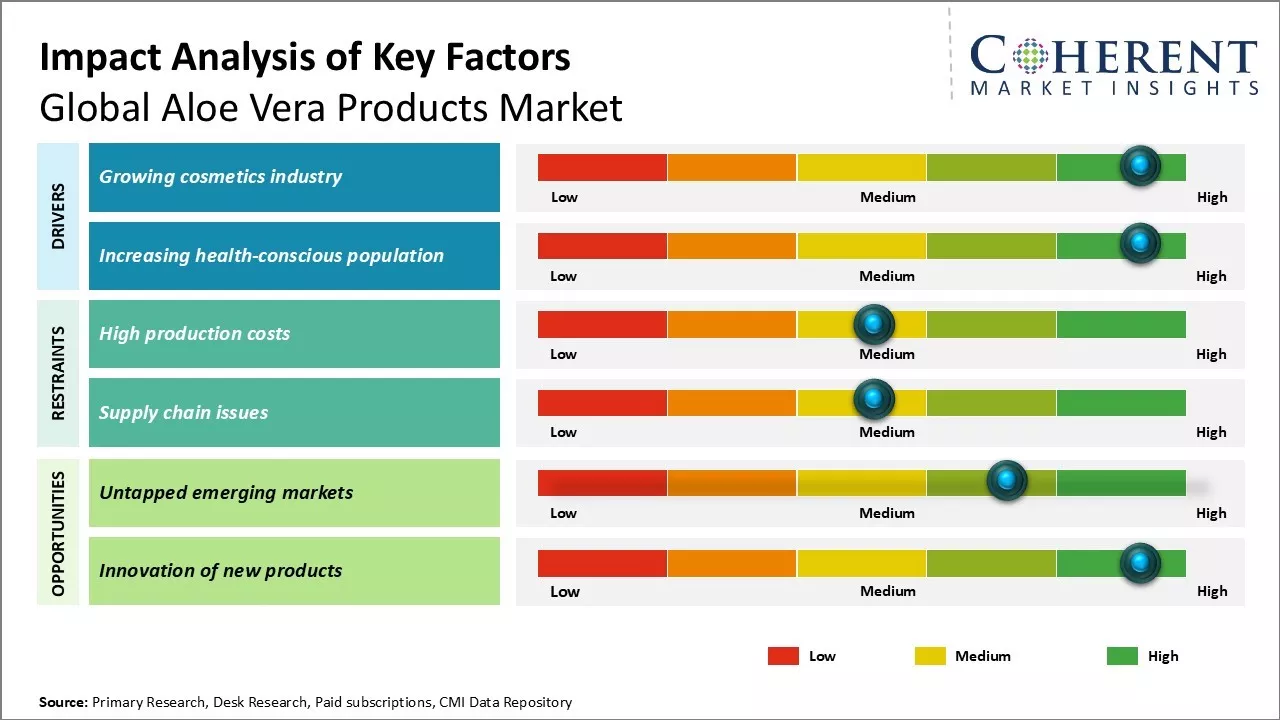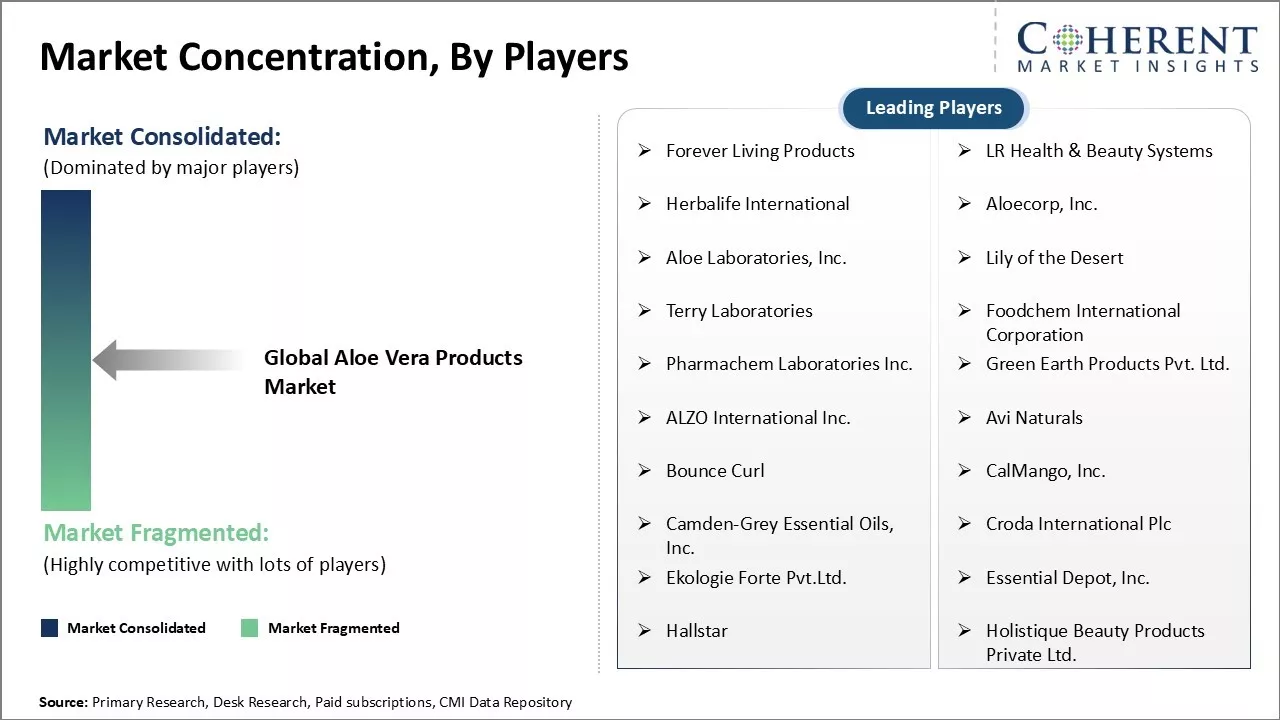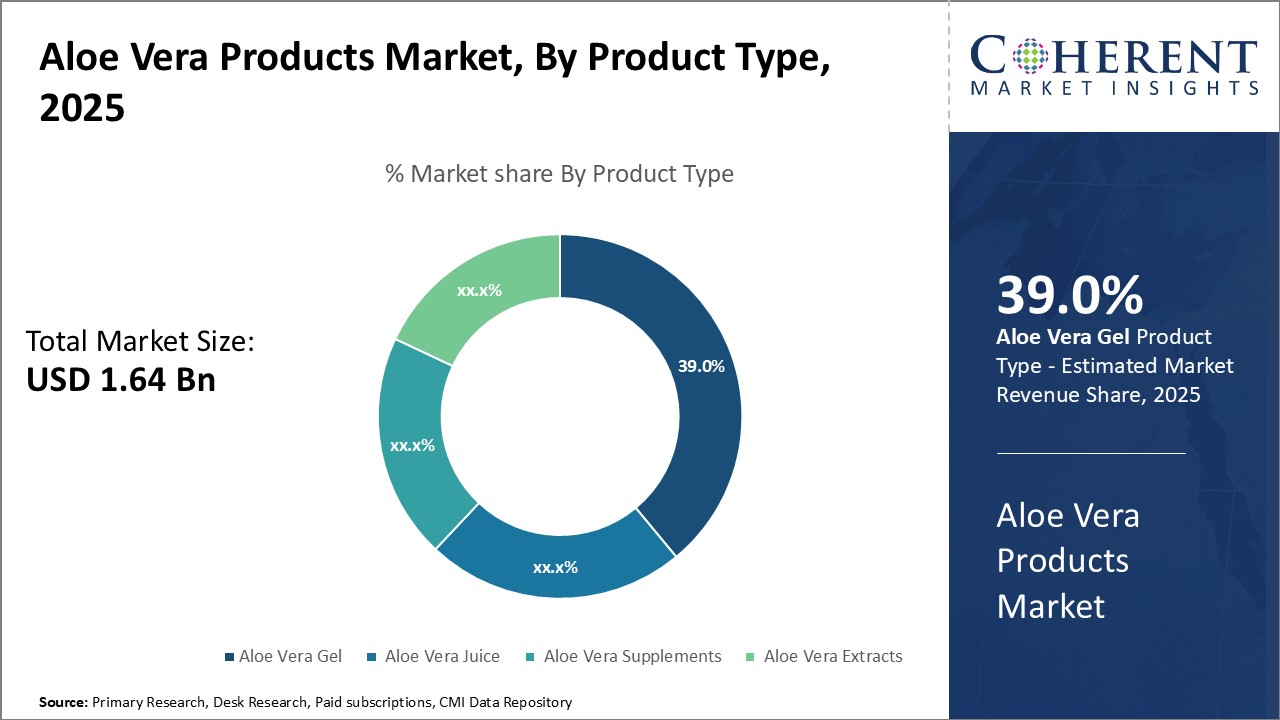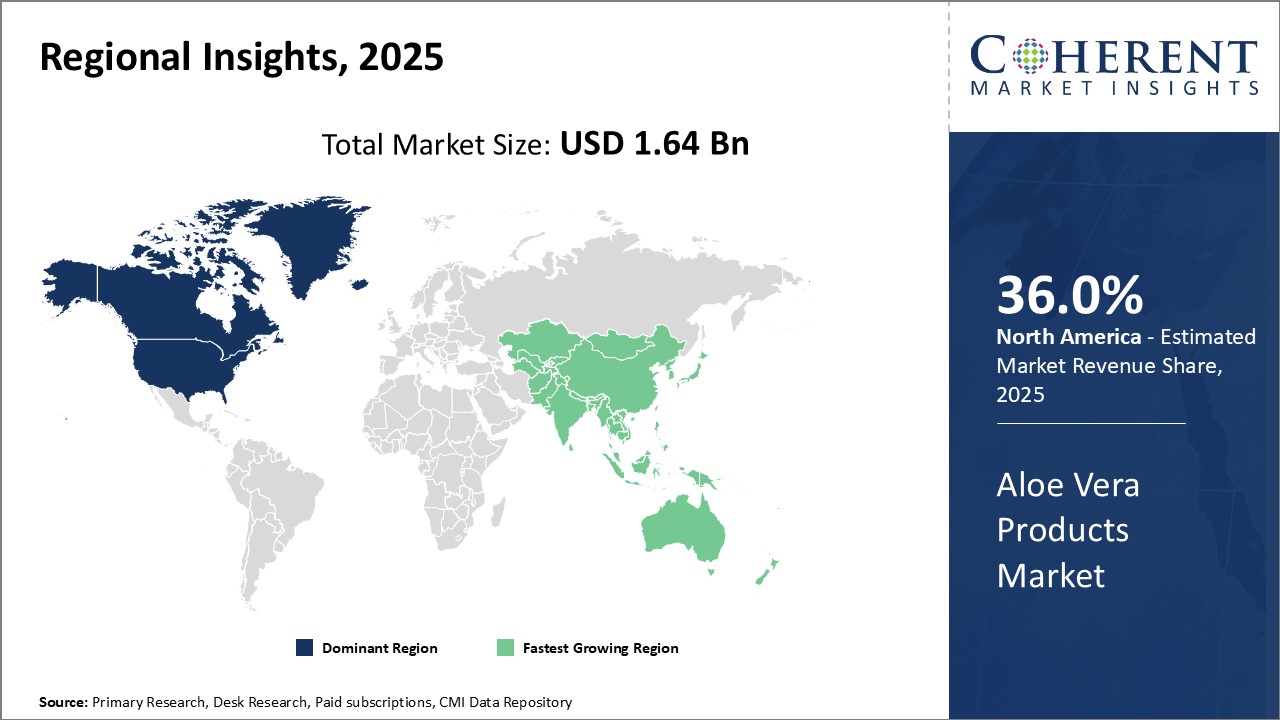Aloe Vera Products Market Size and Trends
The global aloe vera products market is estimated to be valued at USD 1.64 Bn in 2025 and is expected to reach USD 2.75 Bn by 2032, exhibiting a compound annual growth rate (CAGR) of 7.7% from 2025 to 2032.

Discover market dynamics shaping the industry: Download Free Sample
The various health benefits of aloe vera such as alleviating sunburn, reducing inflammation, soothing skin irritation, moisturizing skin, and healing wounds is driving its demand in the cosmetics and pharmaceutical industries. Growing awareness about the medicinal uses of aloe vera extracts to treat conditions like diabetes, cholesterol, inflammation, and constipation is further supporting the growth of the aloe vera products market. The rising demand for natural and herbal personal care products and increasing consumer preference for botanical extracts in cosmetics are expected to drive the consumption of aloe vera extracts and derivatives in the coming years.
Market Driver - Growing cosmetics industry
The cosmetics industry has been growing steadily for the past few decades driven by increasing disposable income and changing lifestyles across major regions. For instance, according to data by IBEF in 2022, the global cosmetics industry is growing at 4.3% CAGR and will reach US$ 450 billion by 2025. Aloe vera has found widespread application in the industry owing to its moisturizing and healing properties. Aloe vera gel extracts help form the base of many skin and hair care products ranging from moisturizers, sunscreens, anti-aging creams to conditioners and shampoos. These gels are known to soothe skin irritation, heal burns, and hydrate the skin due to the presence of vitamins, enzymes, and minerals.
With increasing pollution and environmental damage, more people are facing problems like dryness, acne, wrinkles, etc. at younger ages. This has fueled the demand for natural ingredients that nourish and repair the skin without harsh chemicals. Aloe vera satisfies this need admirably. Products with aloe extract are regarded as mild and suitable for sensitive skin. Many cosmetic brands are highlighting the use of aloe on their packages to attract health-conscious buyers. The expansion of salons and spas that offer aloe-based treatments has further augmented its marketability.
Advancements in skincare science have uncovered more benefits of aloe gel. New research shows they help slow down signs of aging by stimulating collagen production. Their anti-inflammatory properties aid in reducing acne, psoriasis and other skin conditions. Marketing campaigns by cosmetic giants have amplified consumer awareness about these advantages and driven aloe vera product sales. As disposable incomes climb globally, more people are willing to spend on superior quality natural cosmetics. The personal care industry is innovating with aloe vera infused formulations for multi-purpose use as well.
With continuous growth envisaged in the cosmetics market fueled by fashion and beauty trends, the aloe vera extract demand from this sector will keep rising. Expanding retail channels aid market penetration into new regions and demographics. The ongoing push towards organic and eco-friendly personal care ensures a conducive environment for aloe vera products going forward.
Market Concentration and Competitive Landscape

Get actionable strategies to beat competition: Download Free Sample
Increasing health-conscious population
Rising health issues due to sedentary lifestyles and diet changes have made people more conscious about wellness. There is a growing emphasis on preventive healthcare and strengthening the immune system to counter myriad diseases. Aloe vera has emerged as a superfood for its antioxidant, antibacterial and digestive benefits. Its regular consumption is linked to lower risks of diabetes, heart ailments, digestive disorders, and certain cancers.
Medical evidence and traditional wisdom acknowledging aloe's healing qualities have augmented its appeal. People are incorporating aloe vera juice, capsules, and gels as supplements in their daily diets. Some include the plant on their kitchen windowsills and gardens for easy access to fresh leaves to make home remedies. Social media amplifies health information sharing and testimonials have popularized aloe vera consumption for various ailments.
Health experts globally recommend aloe vera to improve nutrient absorption and aid digestion. Its laxative properties bring relief from constipation issues plaguing urban populations. Marketers have capitalized on these useful medicinal attributes through varied product offerings. From immunity boosting drinks to joint pain relief gels, there are tailored solutions for different health goals. Stores are dedicating more shelf space to these items to tap the wellness-conscious demographics.
With lifestyle disorders affecting all age groups now, preventive healthcare has become a primary family concern rather than just for the elderly. Aloe's multi-pronged health benefits and easy availability compared to other superfoods gives it an advantage in this regard. Rising health awareness bodes well for aloe vera products continuing their market growth trajectory.
Key Takeaways from Analyst:
Drivers such as increasing health and wellness trends and broader acceptance of natural and herbal ingredients are expected to propel the demand for aloe vera drinks, gels, and supplements. Additionally, rising awareness about the various medicinal properties and uses of aloe vera extracts for skin, hair, digestion, and other applications will drive consumers to aloe vera products.
Availability of alternative herbal ingredients and natural products poses competition to aloe vera. Further, complexity and challenges in the supply chain of raw aloe vera leaves and potential instability in quality and pricing may act as a restraint to the market.
North America is anticipated to continue dominating the aloe vera products market due to increasing consumer preference for herbal and natural ingredients. Meanwhile, Asia Pacific is likely to witness the fastest gains and emerge as the second largest regional market. Growing health-consciousness and trend towards Ayurveda and traditional medicines will boost the aloe vera demand in the region, especially in India, China, and other economies.
Market Challenge - High production costs
One of the key challenges currently being faced by the global aloe vera products market is the high production costs associated with aloe vera cultivation and product manufacturing. Aloe vera is known to be a labor-intensive crop which requires hand pollination and harvesting of leaves. This makes the production process quite costly. Additionally, factors such as limited availability of farmland for cultivation and high rental costs of such lands in various regions also contribute to the overall expense of aloe vera production. Stringent quality-related compliances for aloe extracts further increases the manufacturing costs. Moreover, the prices of raw aloe vera leaves are also subject to market volatility due to factors like weather conditions and changes in supply and demand dynamics. All these aspects collectively make aloe vera and its by-products a relatively costly natural ingredient. Unless production costs are brought down, it will remain a major challenge for the industry players to price their products competitively without affecting profit margins.
Market Opportunity - Untapped emerging markets
The global aloe vera products market has a huge potential for growth in various emerging economies which remain largely untapped at the present. Regions like Asia Pacific, Latin America, Middle East, and Africa offer massive untapped opportunities due to rising health awareness amongst consumers and growing adoption of herbal and natural products. There is increasing awareness about various medicinal properties and health benefits of aloe vera. This presents lucrative prospects for industry players to foray into new emerging markets and penetrate greater consumer segments. Establishing effective distribution networks and marketing campaigns tailored for local customer preferences can help companies capitalize on these opportunities. Market players need to focus on developing affordable product ranges and formats suitable for the requirements of consumers in developing nations. By addressing the needs of untapped emerging economies, companies can significantly boost overall sales volumes and revenues in the coming years.

Discover high revenue pocket segments and roadmap to it: Download Free Sample
Insights by product type: The versatile benefits of aloe vera gel
In terms of product type, aloe vera gel is expected to contribute 39.0% share of the market in 2025, owing to its wide range of uses. Aloe vera gel contains over 200 active compounds including vitamins, enzymes, minerals, sugars, anthraquinones, lignin, saponins, salicylic acids, and amino acids that provide numerous health and skincare benefits. Its anti-inflammatory, antibacterial and moisturizing properties make it very effective for treating minor burns, skin irritations, sunburns, and reducing signs of aging like wrinkles and dark spots. It soothes itchiness and relieves pains and swelling. Aloe gel is easily absorbed into the skin without leaving a greasy residue. This, along with its natural composition, make it a popular choice for all skin types including sensitive skin.
Aloe gel is commonly used in various skincare and beauty products like facial cleansers, moisturizers, sunscreens, and anti-aging creams. Leading cosmetic brands formulate aloe gel into their products targeting conditions like acne, rosacea and psoriasis. Its wound healing ability also sees use in treatment gels for minor cuts and injuries. Some consumers also prefer to directly apply broken aloe gel from the plant to burns and rashes due to its convenience of use. The rising preference for natural ingredients in personal care coupled with the increased awareness about aloe’s benefits is driving the aloe gel segment. Its safety profile and effectiveness continue to support its wide usage in skin, hair and beauty applications.
Insights by application: The expanding role of aloe vera in digestion and overall wellness
In terms of application, cosmetics and personal care is expected to contribute 39.4% share of the market in 2025. Aloe vera has become a widely recognized and extensively utilized ingredient in the cosmetics and personal care industry. The versatile properties of this succulent plant have made it a popular choice for a wide range of cosmetic and personal care products. One of the primary applications of aloe vera in cosmetics is its use as a skin-soothing and calming agent. Aloe vera's high water content and the presence of compounds such as polysaccharides, vitamins, and minerals make it an effective ingredient in after-sun care products, moisturizers, and even makeup formulations. The cooling and hydrating properties of aloe vera help to soothe and rejuvenate the skin, particularly for those with sensitive or sun-exposed skin.
In addition to its skin-calming benefits, aloe vera is also recognized for its potential to support skin regeneration and promote a healthy complexion. The plant's rich content of antioxidants, including vitamins C and E, as well as its ability to enhance collagen production, make it a valuable ingredient in anti-aging skincare products. Aloe vera-based creams, serums, and lotions are often utilized to address concerns such as fine lines, wrinkles, and uneven skin tone. Beyond its topical applications, aloe vera has also found its way into various personal care products, such as shampoos, conditioners, and hair masks. The plant's moisturizing and soothing properties can help to nourish and protect the scalp and hair, making it a popular choice for individuals with dry, damaged, or sensitive hair and scalp conditions.
Insights by distribution channel: Online retailers front aloe’s accessibility
In terms of distribution channel, online retail is expected to contribute the 35% share of the market in 2025. This is because purchasing aloe vera products via e-commerce provides unmatched convenience to time-strapped customers. Online platforms stock a vast variety of aloe vera formulations including face washes, gels, capsules as well as raw aloe vera products like whole leaves, broken gels, and concentrates. Websites like Amazon and health/beauty specific portals offer these under multiple brands on their user-friendly interfaces and mobile apps.
Consumers can easily compare products, read reviews from other users, add multiple items to their carts and have them delivered right at their doorsteps with just a few clicks. This saves considerable time versus visiting physical stores. E-retailers also provide niche options like organic, non-GMO certified aloe items not easily available locally. Many sites run promotions and seasonal deals that make these purchases more affordable. Especially for aloe vera supplements meant for internal use, customers rely on the anonymity and assortment of online platforms. Live product demos or in-person recommendations from specialists also motivate online purchases.
The growth momentum of e-commerce as a whole complement aloe vera’s increasing popularity. Along with product discoveries, the comfort of shopping from home anytime of the day continues to fuel online aloe sales more than traditional distribution channels.
Regional Insights

Need a Different Region or Segment? Download Free Sample
North America has dominated the aloe vera products market for many years now. The region is expected to hold 36.0% of the market share in 2025. The region has a strong presence of major aloe vera products manufacturers who have established their brands well in the marketplace. Leading manufacturers like Lily of the Desert and Nature's Way have their headquarters based in the U.S. and have a widespread distribution network across the region. Moreover, the health-conscious population in countries like the U.S. and Canada have boosted the demand for natural skincare and health supplement products containing aloe vera.
The regional market is also driven by frequent new product launches that cater to changing consumer preferences. In recent times, aloe vera-based beverages witnessed increased popularity due to the perceived hydrating and antioxidant properties. This has encouraged established players to strengthen their beverage portfolio. Retail shelves in North America are well-stocked with various aloe vera juices, gel drinks and flavored waters throughout the year.
Among emerging markets, Asia Pacific is projected to be the fastest growing regional market for aloe vera products over the next five years. Countries like China, Japan, and South Korea have shown tremendous increase in aloe vera cultivation and processing in the past decade to meet both domestic and export demands. China, in particular, has emerged as a dominant producer and exporter of aloe vera derivatives like polysaccharides and anthraquinones, used in various industries worldwide.
The thriving wellness industry coupled with growing health-savvy urban population in Asia Pacific represents lucrative opportunities for both international as well as domestic aloe vera brands. Besides, constant innovations to align with local taste preferences also drive the regional market growth. For example, aloe vera mixed fruit juices and energy drinks have become favorites of younger consumers in Asia Pacific due to additional functional benefits. With its low production costs and export focus, Asia Pacific is anticipated to play a pivotal role in the global aloe vera products ecosystem.
Market Report Scope
Aloe Vera Products Market Report Coverage
| Report Coverage | Details | ||
|---|---|---|---|
| Base Year: | 2024 | Market Size in 2025: | USD 1.64 Bn |
| Historical Data for: | 2020 To 2024 | Forecast Period: | 2025 To 2032 |
| Forecast Period 2025 to 2032 CAGR: | 7.7% | 2032 Value Projection: | USD 2.75 Bn |
| Geographies covered: |
|
||
| Segments covered: |
|
||
| Companies covered: |
Forever Living Products, LR Health & Beauty Systems, Herbalife International, Aloecorp, Inc., Aloe Laboratories, Inc., Lily of the Desert, Terry Laboratories, Foodchem International Corporation, Pharmachem Laboratories Inc., Green Earth Products Pvt. Ltd., ALZO International Inc., Avi Naturals, Bounce Curl, CalMango, Inc., Camden-Grey Essential Oils, Inc., Croda International Plc, Ekologie Forte Pvt.Ltd., Essential Depot, Inc., Hallstar, and Holistique Beauty Products Private Ltd. |
||
| Growth Drivers: |
|
||
| Restraints & Challenges: |
|
||
Uncover macros and micros vetted on 75+ parameters: Get instant access to report
Aloe Vera Products Industry News
- In 2023, Kelly Loves, a health-conscious beverage brand, announced the launch of its latest product: a pineapple-flavored aloe vera drink. This innovative offering combines the refreshing taste of pineapple with the numerous health benefits of aloe vera, providing consumers with a delicious and nutritious alternative to traditional beverages.
- In 2022, Organic Harvest, a prominent brand known for its commitment to organic and natural products, announced an exciting expansion of its product portfolio with the launch of a new range of aloe vera products. This strategic move aims to meet the growing consumer demand for natural skincare and wellness solutions, leveraging the numerous benefits of aloe vera.
- In 2022, Juicy Chemistry, a renowned brand in the organic skincare and wellness industry, proudly announced the launch of its all-new certified organic aloe vera gel and aloe vera juice. This product line aims to harness the natural benefits of aloe vera, providing consumers with high-quality, versatile options for skincare and health.
- In 2020, Emami Limited, a leading player in the Indian fast-moving consumer goods FMCG sector, expanded its product portfolio by launching an organic aloe vera gel under its well-known BoroPlus brand. This launch was part of Emami Ltd. commitment to providing natural and effective skincare solutions to consumers, leveraging the numerous benefits of aloe vera.
*Definition: The global aloe vera products market represents the market for various consumer goods and cosmetic products that contain aloe vera as a key ingredient. This includes aloe vera gels, lotions, drinks, juices, supplements, and other topical applications that leverage the anti-inflammatory, antiviral, and moisturizing properties of aloe vera. The market covers a wide range of aloe vera-based skincare products for conditions like sunburn, as well as aloe vera-fortified drinks and nutritional supplements sold globally.
Market Segmentation
- Product Type Insights (Revenue, USD Bn, 2020 - 2032)
-
- Aloe Vera Gel
- Aloe Vera Juice
- Aloe Vera Supplements
- Aloe Vera Extracts
- Application Insights (Revenue, USD Bn, 2020 - 2032)
-
- Cosmetics and Personal Care
- Food and Beverage
- Pharmaceuticals
- Others
- Distribution Channel Insights (Revenue, USD Bn, 2020 - 2032)
-
- Online Retail
- Supermarkets/Hypermarkets
- Health Stores
- Others
- Regional Insights (Revenue, USD Bn 2020 - 2032)
-
- North America
- U.S.
- Canada
- Latin America
- Brazil
- Argentina
- Mexico
- Rest of Latin America
- Europe
- Germany
- U.K.
- Spain
- France
- Italy
- Russia
- Rest of Europe
- Asia Pacific
- China
- India
- Japan
- Australia
- South Korea
- ASEAN
- Rest of Asia Pacific
- Middle East
- GCC Countries
- Israel
- Rest of Middle East
- Africa
- South Africa
- North Africa
- Central Africa
- North America
- Key Players Insights
- Forever Living Products
- LR Health & Beauty Systems
- Herbalife International
- Aloecorp, Inc.
- Aloe Laboratories, Inc.
- Lily of the Desert
- Terry Laboratories
- Foodchem International Corporation
- Pharmachem Laboratories Inc.
- Green Earth Products Pvt. Ltd.
- ALZO International Inc.
- Avi Naturals
- Bounce Curl
- CalMango, Inc.
- Camden-Grey Essential Oils, Inc.
- Croda International Plc
- Ekologie Forte Pvt.Ltd.
- Essential Depot, Inc.
- Hallstar
- Holistique Beauty Products Private Ltd.
Share
Share
About Author
Yash Doshi is a Senior Management Consultant. He has 12+ years of experience in conducting research and handling consulting projects across verticals in APAC, EMEA, and the Americas.
He brings strong acumen in helping chemical companies navigate complex challenges and identify growth opportunities. He has deep expertise across the chemicals value chain, including commodity, specialty and fine chemicals, plastics and polymers, and petrochemicals. Yash is a sought-after speaker at industry conferences and contributes to various publications on topics related commodity, specialty and fine chemicals, plastics and polymers, and petrochemicals.
Missing comfort of reading report in your local language? Find your preferred language :
Transform your Strategy with Exclusive Trending Reports :
Frequently Asked Questions
EXISTING CLIENTELE
Joining thousands of companies around the world committed to making the Excellent Business Solutions.
View All Our Clients
